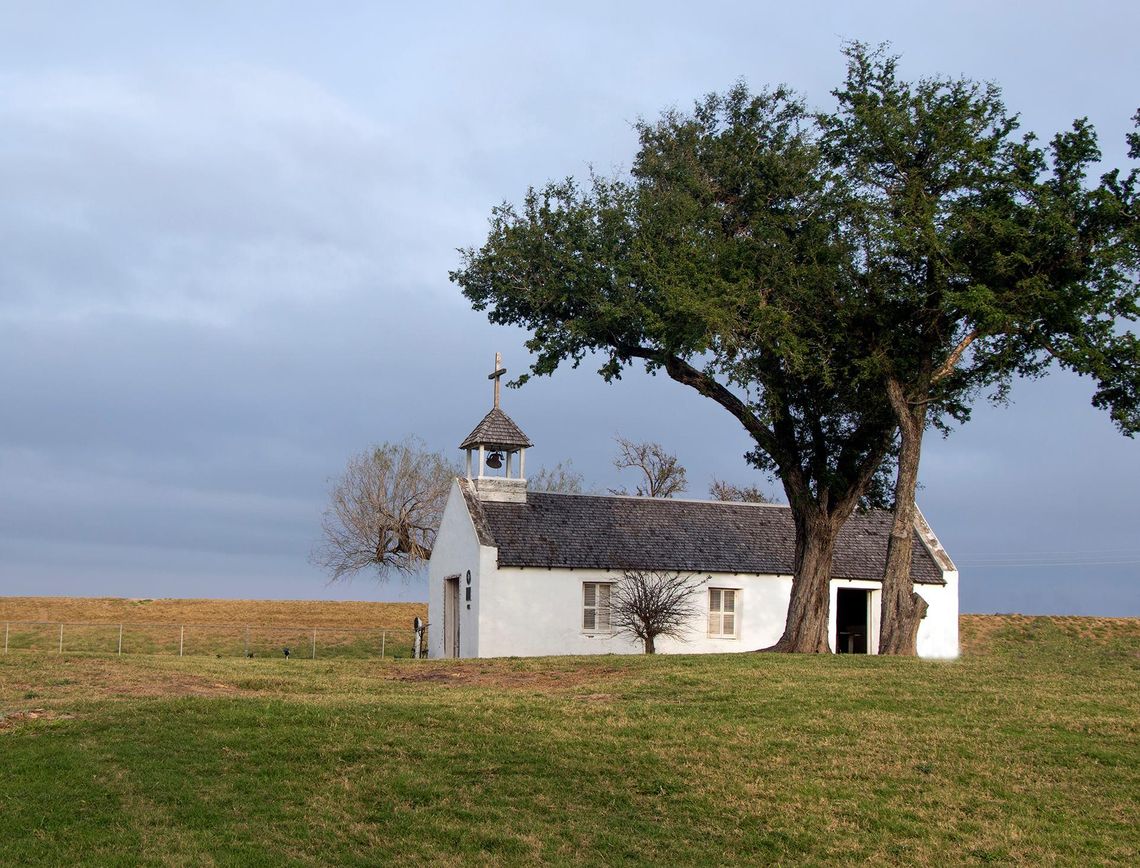The irony hadn’t escaped me. In anticipation of a discussion I was to have the following week, I had traveled to the Lower Rio Grande Valley with a copy of John Graves’ 1960 classic “Goodbye to a River” in the front seat of my car. This was that Texas writer’s account of a canoe trip down the Brazos, his farewell to a stretch of the river that was scheduled to dammed and thus destroyed in the very near future. For a number of reasons, that destruction never occurred. If only the same outcome would happen here, I’d be thrilled. But it wasn’t looking good.
I was heading to the Valley — specifically, the town of Mission — to participate in a hike being sponsored by the grassroots organization No Border Wall. We were to gather Sunday afternoon at Bentsen-Rio Grande Valley State Park, talk about the current status of the border wall, and then take a walk to the Hawk Tower to get a view of the land under threat.

Scott Nicol, a member of No Border Wall, shows his sentiment with a T-shirt.
As group leader Jonathan Salinas explained, El Morillo Banco, the 654-acre national refuge that sits between Bentsen-Rio Grande and the National Butterfly Center, would be the first to go. That parcel is just one of the 80 sites that comprise the Lower Rio Grande Valley National Refuge, a fact I hadn’t known until then. This refuge system, Salinas’ colleague Stefanie Herweck told the group, was established by the federal government in 1979 to create a corridor for wildlife along the Rio Grande River. Recognized as one of the most biologically diverse habitats in North America, “the refuge follows the Rio Grande along the last 275 river miles, connecting isolated tracts of land managed by private landowners, non-profit organizations, the State of Texas, and two other National Wildlife Refuges, Laguna Atascosa and Santa Ana.” Clearly, the U.S. Fish & Wildlife Service, which manages the refuge, sees the need for animals to have uninterrupted access to wild land, 95 percent of which has disappeared in the Valley since 1939.
Was this a case of one government agency trumping another? Pun intended. It seemed it was.
The meeting was lively and filled with passionate voices. Most people were from the area — McAllen, Mission, Alamo — but a few, like me, had traveled from Central Texas. Also sprinkled through the crowd of about 50 were “snowbirds” from places such as Ohio and Illinois. A number of us were educators of some sort, including a public policy expert from Brownsville and a retired special education teacher from Austin. Several were members of the Environmental Awareness Club from the University of Texas Rio Grande Valley in Edinburg. We were young and old, Anglo and Latino, longtime activists and newbies to the cause. After the meeting, the students from the EAC shared chocolate chip cookies and brownies with the group; a young man brought out a cooler full of empeñadas he’d made with his dad that morning. It was just that sort of event.
The hike to the Hawk Tower was about three miles round trip. I was already sore from trekking through the park all day, with my 10-pound camera and lens in tow, but there was no way I was staying behind. As we walked and the afternoon waned, we spotted a Harris hawk in the skeleton of a tree some distance away, and listened to the chatter of green jays and great kiskadees, two of the signature birds of the Lower Rio Grande.

This sign marks the El Morillo Refuge property between the Butterfly Center and Bentsen-Rio Grande Valley State Park. This refuge is where construction on the border wall began this week. Susan Hanson photos
ʻThe Landʼ
It’s hard to know where one parcel of land ends and another begins down here. Mesquite trees make poor landmarks, and the resacas that appear one season may well be dry in the next. “That’s Mexico where you see all the buildings,” Jonathan Salinas said as he pointed west toward a river we couldn’t see. “And that’s El Morillo,” he added, spinning and gesturing toward the south. I was clearly turned around.
But that’s part of the point, I think. Directions, like landmarks, are of little help to me in this place. They’re of little help to wildlife, too. To the endangered ocelot and jaguarundi, there is only dense stands of granjeno and colima, Texas ebony and anacua. To the javelina and Texas tortoise, there is only prickly pear and mesquite beans. To the plain chachalacas and Altamira orioles, there is only the fruit of hog plum and hackberries, la coma and brasil. And to everything, there is the Rio Grande and its oxbows or resacas, the lifeblood of this magical place.
According to U.S. Fish & Wildlife, “the lower four counties of Texas contain a documented 1,200 plants, 300 butterflies, and approximately 700 vertebrates, of which at least 520 are birds.” Eleven species of bats, four types of cats, beaver and white-nosed coati, neotropic cormorants and common loons — for all of these, there is simply “the land,” the stretch of earth that supports them, unbroken and unfenced.
“But we have to do something,” a friend argued when I told her where I’d been and what I’d done while I was there. “I’ll grant you that,” I told her. “But must there be a wall?”

Border patrol cruising the road atop the levee.
ʻTactile Infrastructureʼ
I have a confession to make: This land is not my land, not in the way that the Hill Country is. I’m talking land that you feel in your bones, land that you know as thoroughly as you know your own heart. Instead, this is the place where my Aunt Pearl lived on a farm with my uncle R.C. It is the place where I slept, as a child, with my small face pressed against the window screen, desperately trying to find air in the humid summer heat. And it is the place where, while wandering one morning through my uncle’s field of corn, I ran from the crop duster flying low over his neighbor’s land, leaving a thick fog of chemicals in his wake. In short, the associations haven’t been good.
That changed, however, in the fall of 2015 when I adopted the book Continental Divide: Wildlife, People, and the Border Wall for use in my spring 2016 honors nature writing class. That spring I also arranged for its author, photojournalist Krista Schlyer of Washington, D.C., to visit campus and speak to my class and others. Getting to know Krista hooked me. Thanks to her, and a host of intangibles I can’t name, I suddenly cared what happened to the land I had disregarded as a child. I cared that a wall was going to bisect the habitat of all the wildlife I had come to love, that it was going to keep some animals from accessing the river, and drown others — like the Texas tortoises — when it floods. I cared that people would lose their homes, that ranches would be cut in half, that scores of environmental laws would be broken, that a historic church would be lost, that a beloved state park would close—and all because of fear.
“It won’t happen,” friends have told me, imagining that the wall will go the way of other controversial projects that have failed. What they and others don’t realize, however, is that, totally separate from the current debate, Congress has had $1.6 billion for border wall construction and repair sitting in its pocket since March of 2018. Among the sections it has already funded is “six miles of levee wall system,” a $145 million contract awarded to Sisco Corporation of Galveston last October.
This “tactile infrastructure,” as U.S. Customs and Border Protection euphemistically called it in a news release on the subject, will in reality be a “reinforced concrete levee wall to the height of the existing levee [12-18 feet], 18 feet tall steel bollards installed on top of the concrete wall, and vegetation removal along a 150 foot enforcement zone throughout the approximately six miles of levee wall system. The enforcement zone will also include detection technology, lighting, video surveillance, and an all-weather patrol road parallel to the levee wall.”
We’re talking scorched earth here, a scar the width of a football field in some cases miles inland from the Rio Grande, creating a no-man’s land between the river and the wall. We’re talking bright lights day and night, disorienting wildlife and obscuring the starry sky. And all for what?
ʻA Precious Relic of the Pastʼ
The first piece of heavy equipment arrived on Sunday afternoon. There was talk that the driver tried to bring it into the park, and talk the next morning that he had left it at the Butterfly Center down the road. I visited the Center Monday morning to see if that was true and learned that it was — in part. As a staff member told me, the earth mover had been parked there overnight, but had been hauled away by the time employees went down to see it. Not surprisingly, the tracks in the mud led next door to El Morillo, where work would begin on Monday.
With “Goodbye to a River” in my car, I had visited the Butterfly Center and Bentsen-Rio Grande State Park. I had stood in the chapel of La Lomita and read of its designation as “a precious relic of the past and a Shrine to Our Lady of Guadalupe.” I had crossed the levee and stood on the banks of the Rio Grande in Anzalduas Park, watching snowy egrets assemble themselves on the wreckage of a pier. “I’m watching birds,” I had told the Border Patrol agent when he stopped his car by mine while I was looking for a map on my phone. He had looked suspicious, but smiled.
Sitting in my car at the Butterfly Center on Monday morning, I debated my reasons for going to the Rio Grande Valley. Perhaps I was saying my own goodbye to everything I had seen, or perhaps I was saying I’ll engage in the struggle to determine what happens next. Knowing I was there to witness what is being done in that rugged but fragile place, I sensed there was more to do. I picked up my phone, and called my senator’s office.
Editor’s note: Hanson is a former San Marcos Daily Record staff member







